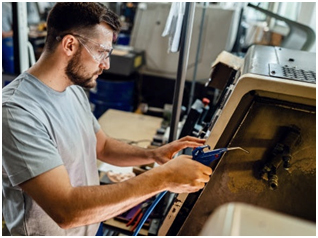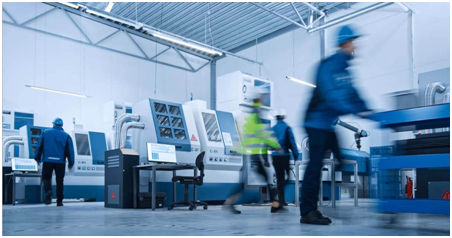
Introduction
In the heart of modern manufacturing, CNC (Computer Numerical Control) machines stand as the ultimate precision tools, transforming raw materials into intricate components with unrivaled accuracy. Yet, amid the marvel of automation and innovation, a silent sentinel watches over the workshop – safety. At Jaewoo Machines, we understand that safety should never be an afterthought in the world of CNC machining. Instead, it should be at the forefront of every operator’s mind, guiding every action, and shaping every decision.
In this blog, we embark on a journey through the realm of CNC machine operations, exploring the safety guidelines that are essential to a secure and productive work environment. Whether you’re a seasoned expert or just beginning to acquaint yourself with the world of CNC, our comprehensive guide will equip you with the knowledge you need to keep yourself and your equipment safe. Let’s delve into the world of CNC machine safety and learn how to safeguard lives, protect equipment, and ensure compliance with industry standards.
The Importance of CNC Machine Safety

As we dive into this subtopic, we’ll uncover the profound reasons why CNC machine safety should be a top priority for manufacturers, operators, and anyone associated with the realm of precision machining. From protecting lives to preserving valuable equipment and staying in compliance with industry regulations, the importance of CNC machine safety is truly boundless.
Join us as we unravel the layers of this crucial aspect of CNC machining, shedding light on the practices, guidelines, and principles that ensure a safer and more productive future in the world of precision manufacturing.
Before delving into the specific safety guidelines, let’s understand why prioritizing safety in CNC machining is so critical.
Protecting Lives and Limbs
CNC machines operate at high speeds and precision, making them incredibly efficient but potentially dangerous. Ensuring the safety of machine operators and other personnel in the vicinity is paramount to avoid accidents and injuries.
Safeguarding Equipment
CNC machines are significant investments for any manufacturing facility. Proper safety practices can help prevent costly damage or breakdowns, extending the lifespan of these valuable assets.
Legal and Regulatory Compliance
Compliance with safety regulations and standards is not just a moral duty but also a legal requirement. Failure to adhere to safety guidelines can result in penalties, lawsuits, and reputational damage for a manufacturing company.
Essential Safety Practices for CNC Machine Operators
 Here, we’ll delve into the very essence of CNC machine safety, recognizing that the wellbeing of operators, equipment, and the reputation of manufacturers hinges upon adherence to these essential practices. Whether you’re a seasoned professional seeking to enhance your knowledge or a novice entering the world of CNC machining, these guidelines will serve as your compass to navigate the intricate landscape of precision manufacturing safely and effectively.
Here, we’ll delve into the very essence of CNC machine safety, recognizing that the wellbeing of operators, equipment, and the reputation of manufacturers hinges upon adherence to these essential practices. Whether you’re a seasoned professional seeking to enhance your knowledge or a novice entering the world of CNC machining, these guidelines will serve as your compass to navigate the intricate landscape of precision manufacturing safely and effectively.
Join us as we unravel the secrets to a safer and more productive CNC machine operation. Let’s explore how proper training, the use of personal protective equipment, and meticulous attention to detail can ensure a secure and thriving future in the realm of CNC machining.
Now that we understand the importance of CNC machine safety, let’s explore some essential practices that operators should follow.
Training and Education
Proper training is the foundation of CNC machine safety. Operators must undergo comprehensive training programs to learn how to operate the machines, understand safety protocols, and troubleshoot common issues.
Personal Protective Equipment (PPE)
Wearing appropriate PPE is non-negotiable when working with CNC machines. This includes safety glasses, ear protection, gloves, and steel-toed shoes. PPE helps protect operators from flying debris, loud noises, and potential contact with rotating or moving parts.
Machine Inspection and Maintenance
Regular inspections and maintenance checks are essential to identify and address potential safety hazards. Operators should inspect the machine before each use, looking for loose parts, damaged components, and signs of wear.
Workspace Organization
Maintaining a clean and organized workspace is crucial for safety. Cluttered work areas increase the risk of accidents, such as tripping or falling. Keep tools, materials, and debris properly organized and stored.
Emergency Procedures
Operators should be well-versed in emergency procedures, including how to stop the machine in case of an emergency, use fire extinguishers, and administer basic first aid if needed. Posting emergency contact information is also advisable.
Specific Safety Precautions
- Ask the instructor’s approval.
- Without first contacting an instructor and getting their approval, do not change or adjust any equipment, tools, or accessories.
- Go over all of the supplied CNC setup and operation instructions.
- Go over all of the included CNC programming instructions.
- Carefully prepare and go over your program.
- Check your program for clarity, correctness, format, and safety.
- Verification of all programs is strongly advised prior to the machine’s actual trial. A dry run on the machine or a visual representation of the tool path on the controller’s screen might be used for verification. If you are not completely comfortable using a machine tool, do not operate it.
- Put on safety footwear.
- Fasten long hair or loose garments that might get entangled in the machine’s moving parts. Long hair poses a serious risk to safety when near machinery, so it needs to be netted.
- Put on your safety glasses.
CNC Machine Operation Safety
 Whether you’re a seasoned CNC machine operator looking to refine your safety protocols or someone venturing into the world of precision manufacturing for the first time, this guide will equip you with the knowledge and tools to navigate the intricate terrain of CNC machine operation safely and effectively.
Whether you’re a seasoned CNC machine operator looking to refine your safety protocols or someone venturing into the world of precision manufacturing for the first time, this guide will equip you with the knowledge and tools to navigate the intricate terrain of CNC machine operation safely and effectively.
Throughout this journey, we will unravel the critical components of CNC machine safety, from machine setup and tool selection to continuous monitoring and safe shutdown procedures. Each step is a vital note in the symphony of safety that ensures the wellbeing of operators, the longevity of equipment, and the integrity of manufacturing processes.
In this section, we will focus on safety guidelines directly related to the operation of CNC machines.
Machine Setup
Before starting the machine, ensure that the workpiece is properly secured to prevent it from becoming dislodged during machining. Check that all clamps and fixtures are in place and tightened.
Tool Selection and Inspection
Select the appropriate cutting tools based on the material and machining process. Inspect tools for signs of wear, damage, or dullness. Dull tools can lead to poor-quality cuts and increased risk of accidents.
Spindle Speeds and Feeds
Adhere to recommended spindle speeds and feed rates to ensure the tool performs optimally. Operating the machine at incorrect speeds can result in tool breakage, damage to the workpiece, and safety hazards.
Continuous Monitoring
Operators should closely monitor the machining process. Pay attention to any unusual noises, vibrations, or irregularities in the tool’s behavior. If something seems off, stop the machine immediately and investigate the issue.
Safe Shutdown
When finishing a job or in case of an emergency, always follow proper shutdown procedures. This includes stopping the spindle, returning the tool to a safe position, and turning off the machine. Never leave the machine unattended while it is running.
CNC Machine Maintenance and Servicing
 In the realm of precision manufacturing, where technology meets ingenuity, CNC (Computer Numerical Control) machines are the architects of intricate precision. These mechanical marvels have revolutionized how we craft precision components, setting new standards for accuracy and efficiency. Yet, in the grand symphony of automation and precision, there’s an essential note that must never be ignored – maintenance.
In the realm of precision manufacturing, where technology meets ingenuity, CNC (Computer Numerical Control) machines are the architects of intricate precision. These mechanical marvels have revolutionized how we craft precision components, setting new standards for accuracy and efficiency. Yet, in the grand symphony of automation and precision, there’s an essential note that must never be ignored – maintenance.
In this comprehensive guide, we will delve into the core principles, practices, and procedures that keep CNC machines running at their best.
Whether you are a seasoned CNC machine operator well-versed in the intricacies of maintenance or a newcomer seeking to understand the importance of servicing, this guide will equip you with the knowledge and tools needed to maintain a well-oiled, precision-producing operation.
Throughout our journey, we will uncover the key components of CNC machine maintenance, from scheduled upkeep and routine inspections to the vital lockout/tagout procedures that keep both operators and equipment safe during servicing.
Regular maintenance is essential for the long-term safety and performance of CNC machines.
Scheduled Maintenance
Create a maintenance schedule that includes routine inspections, lubrication, and component replacements. Stick to this schedule to prevent unexpected breakdowns.
Lockout/Tagout Procedures
When performing maintenance or servicing tasks, use lockout/tagout procedures to isolate the machine from its power source. This prevents accidental startup and ensures the safety of maintenance personnel.
Conclusion
In conclusion, prioritizing safety in CNC machine operations is not only a moral obligation but also a legal requirement that protects lives, equipment, and a company’s reputation. Operators must receive proper training, wear the necessary PPE, and adhere to safety guidelines at all times. By following these essential practices, we can create a safer and more productive manufacturing environment.
In the intricate dance of precision that CNC machines perform, safety is the steady rhythm that keeps the performance on track. As we conclude this exploration of essential safety guidelines for CNC machine operators, it’s clear that prioritizing safety isn’t just a necessity; it’s a responsibility.
